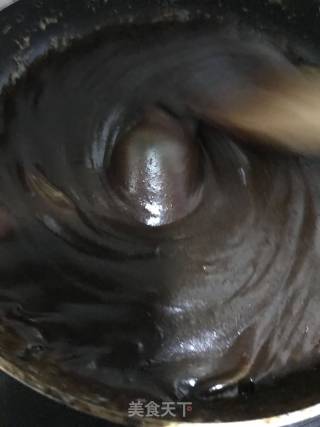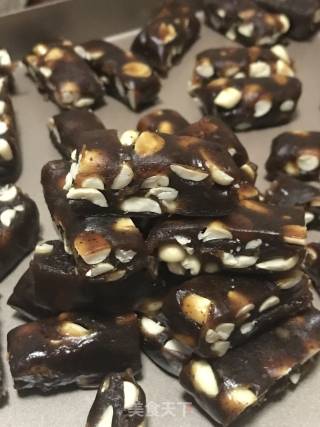Jujube Peanut Candy
1.
I use gray dates, if you use large dates, you can use less.
2.
Red dates are pitted with scissors.
3.
After going to the nuclear and washing, add water to submerge the red dates.
4.
Boil until the water is half less than the original.
5.
Put the peanuts in the middle of the oven at 160 degrees for 10 minutes, and adjust the temperature according to your own oven.
6.
Take the roasted peanuts out, grab a handful and rub your hands together, so that you can rub off the red peanuts. The roasted peanuts can be rubbed off easily.
7.
After rubbing, hold the plate in both hands and keep tossing the skin and it will fly out by itself, so just swipe it clean. Or blow it lightly, and the red peanuts will fly out...
8.
This is cleaned up, soon.
9.
The boiled red dates are taken out and put into a wall-breaking machine to mud. If the machine is strong, it can be beaten directly without peeling. If you don't work hard, you can peel off the skin with your hands and beat it into mud. If you really don't want to peel it, just put the machine into mud and sift it. The machine is not strong, and it will still be a little skiny after the process. Or go through the sieve directly, but the sieve is larger. Anyway, use the steps you like.
10.
Sifted.
11.
Prepare combination A.
12.
Combination B is ready, stir it before use, starch will settle.
13.
Combination C is ready.
14.
Put combination A in a non-stick pan and start boiling the syrup.
15.
Let it boil, stirring from time to time, and try to heat it evenly! When the syrup starts to bubble more densely, you can turn off the heat and add combination B.
16.
You can also put a thermometer into it. When the temperature reaches 130 degrees, you can turn off the heat and add it to Combination B.
17.
Add a little bit while stirring in circular motions.
18.
Stir well and add combination C
19.
Turn on the fire, mix well on medium heat, and the hardened syrup on the side of the pot will scrape it up and stir! When the syrup is boiling again, add jujube puree and start frying! Continue to draw circles and fry.
20.
Stir-fry all the time like this, after which it is the process of draining the water. Throughout the heat, keep stirring, scrape the jujube pulp on the edge of the pot with a heat-resistant spatula from time to time. After it is dried to a certain extent, scraping is no longer necessary, and the mixture in the pot will start to clump. After starting to form a group, gradually reduce the firepower to medium and small fires.


21.
Keep cooking until the mixture picks up and becomes a soft ball. (If you need to judge by experience, or when the fluidity is very slow, adjust to the lowest heat and use the ice water prepared in advance to test the state. Take a little bit of the finished product and put it on Put it in the ice water and feel the pinch after it cools. What you want is a semi-solid, elastic and Q-like feel. Continue to stir fry in the pot, but at the lowest heat, until it reaches the best state, then add it to the roast Spread the fragrant peanuts evenly so that the jujube paste is wrapped!) Press with a spatula and stick it with the sugar.
22.
Take it out of the pot, pour it on the prepared non-stick baking silicone oil paper, keep pressing, that is, fold it inward, so that the peanuts and jujube puree can be seamlessly bonded together.
23.
Wear gloves for heat insulation, or you will get soup. Fold and press the sugar ball from all sides to the center several times through the paper, the peanuts and the sugar ball will be more evenly bonded.
24.
Finally, put it in the mold to shape it, roughly forming a rectangle. You can also use paper to fold it from four sides, leaving some space, and fold it into a rectangular paper bag. Turn it over and use a rolling pin to flatten the sugar balls in the paper bag. The paper bag is equivalent to a flexible mold. If you feel that it is too thick after rolling it out, refold the paper, loosen some size, and roll it out again.
25.
After letting cool thoroughly, cut into pieces with a knife. Don't go down with a knife, cut back and forth with the knife. Wrap it with sugar paper and it's done. This sugar is a bit sticky. Most of the sugar papers you buy now are coated and won't stick.
26.
Finished picture.
27.
Finished picture.


Tips:
1. The common situation is that the finished product is too soft or too hard, and it is soft because it is not properly fried. When frying in a pot, it is faster to get a soft dough from a muddy shape, and dry enough from a soft dough shape. This process is relatively long, the progress is slow, the firepower is not large, and it can only be turned slowly, etc. The water evaporates. Don't over-fry, too, it will be very hard, and the teeth will stick to the knife if you can't cut it.
2. If you really can't grasp the degree of softness and hardness, you can prepare a bowl of ice water in advance, put it in the water and let it cool, and then try the degree of softness and hardness. What is important is that the semi-solid is more elastic than the Q state.
3. If you feel too sweet, you can avoid brown sugar, if you want to reduce the sweetness, don't reduce maltose, don't reduce maltose, don't reduce maltose! Almost all the water evaporates during the frying process. The main ingredients of a candy are basically jujube puree and sugar. The sweetness is jujube puree. Maltose is much lower in sweetness than jujube puree. The more maltose is reduced, the sweeter it is, and the sugar will be softer. You can find some less sweet dates to make, or simply increase the amount of maltose.
4. Red dates are the amount before pitting. Adjust the amount according to the size of the red dates you use. If you use jujubes, such as tribute dates, you can reduce the number of points in grams.
5. If you don't like peanuts, you can also use walnut meat or other nuts, depending on your preference. But the raw must be baked before it tastes good.